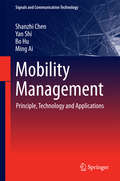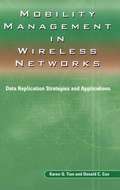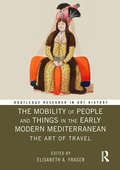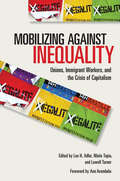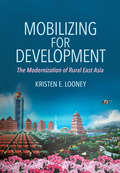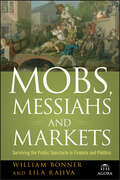- Table View
- List View
Mobility in Germany: Digital Transformation, Megatrends and the Evolution of New Business Models (SpringerBriefs in Business)
by Cordelia Friesendorf Luca UedelhovenMobility in Germany is embracing market changes like never before. Megatrends, notably, digitalization, urbanization and sustainable thinking are driving Germany’s mobility transformation such that traditional players are rethinking their business models and new companies are constantly seeking market penetration. This book captures these changes in a holistic approach to depict Germany’s mobility transition driven by innovation. Beginning with an evaluation of the market environment and megatrends impacting mobility, the book compares and contrasts traditional mobility business models with those of the new entrants. Using business management techniques and a detailed survey on customer perspectives, this book equips mobility professionals, policymakers, entrepreneurs and researchers with concise, critical and up-to-date analysis of the developments in German mobility and provides valuable insights into new business models that offer user-oriented, futuristic and sustainable mobility solutions.
Mobility in Space and Time: Challenges to the Theory of International Economics (Contributions to Economics)
by Nicole PohlThe pure theory of international economics operates within a methodological framework of (static) equilibrium modelling. This sets a number of restrictions to its capability to explain empirical economic phenomena. A huge part of the scientific discourse takes place within this equilibrium framework. This is also true for new approaches like e.g. the New Economic Geography and models operating with market structures of oligopoly. This is why it is a courageous effort to try to cross the apparently unalterable borders set by equilibrium modelling. Most certainly this cannot be an end in itself. Especially the pure theory of international economics is still in many fields lacking adequate possibilities to deal with phenomena in space and time. These two dimensions have in common that they make the introduction of specific facets of movement, change, evolution - and therefore "mobility" - possible. Besides this "dynamic" component a point of view that includes space and time challenges us to find new possibilities to model heterogeneous agents. If these ideas are not so revolutionary in their content, the attempt to introduce them into a formal model is a big challenge. Moreover, it poses the question about the role of a theory of "international" economics in such a wider framework.
Mobility, Labour Migration and Border Controls in Asia
by A. Kaur I. MetcalfeOne of the biggest challenges facing the Asia-Pacific region in the 21st century is the large scale cross-border movement of people. This book explores: sovereignty; security issues and border-management strategies of major states, in the face of intensified transnational economic and social processes; and the expanding global governance regime.
Mobility Management: Principle, Technology and Applications (Signals and Communication Technology)
by Shanzhi Chen Yan Shi Bo Hu Ming AiThis is the first book devoted to mobility management, covering the important principles, technologies and applications of mobility management based on years of academic research and industry experiences. The content is organized according to the reference models proposed by the authors, and emphasizes on technical principles rather than protocol details; a systematic and comprehensive introduction is presented yet without losing focuses; the existing technologies in cellular system, mobile Internet and IMS/SIP are also extensively compared. This book can be an indispensable reference for mobile communication engineers, computer network engineers, researchers and anyone else involved in academic, industrial and standardization activities on mobility management.
Mobility Management in Wireless Networks: Data Replication Strategies and Applications (Ercoftac Ser.)
by Karen Q. Tian Donald C. CoxIn wireless communication systems, the network keeps track of a user’s location through an up-to-date user profile stored in various databases. A user profile contains not only a user’s current location information, but also service information, such as billing and authentication. The cov- age area of an access network is divided into registration areas (RAs), and each RA is associated with a location database. The two basic op- ations in mobility management are location update and location lookup. When a user moves across the boundaries of these RAs, the network updates his location information in the pertinent databases. When a caller places a call using the callee’s identification, the network queries the relevant database(s) to obtain the current location and other service information of the callee. The performance of mobility management can be further enhanced by using replicas of user profiles which may be kept at various locations. Replication techniques make profile information more readily available, thus reducing lookup cost and latency, but to keep these replicas c- sistent and fresh, they must be updated whenever the user profile is updated. The principle of replication is to replicate if the benefit of replication is greater than its overhead. The difficulty, however, lies in accurately measuring the benefit and overhead.
Mobility of Health Professionals: Health Systems, Work Conditions, Patterns of Health Workers' Mobility and Implications for Policy Makers
by Frits Tjadens Caren Weilandt Josef EckertThis book on mobility of health professionals reviews, analyses and summarises published information and data as well as collected interview data from stake holders, including politicians, policy makers, health service managers and migrant health workers. It is based on the research carried out under the umbrella of the EU-funded project “Mobility of Health Professionals (MoHProf).The partners involved in the MoHProf project gathered evidence from 25 countries around basic questions and knowledge gaps relating to the international migration of health professionals, which involved an analysis of migration flows and evaluation of policies addressing migration. This book provides a comprehensive description and analysis of the mobility streams, the motives and driving forces behind them and the impact on and challenges for health systems and draws conclusions and provides recommendations for future strategic planning, monitoring and the management of mobility of health professionals as well as further research and policy development needs.
The Mobility of People and Things in the Early Modern Mediterranean: The Art of Travel (Routledge Research in Art History)
by Elisabeth A. FraserFor centuries artists, diplomats, and merchants served as cultural intermediaries in the Mediterranean. Stationed in port cities and other entrepôts of the Mediterranean, these go-betweens forged intercultural connections even as they negotiated and sometimes promoted cultural misunderstandings. They also moved objects of all kinds across time and space. This volume considers how the mobility of art and material culture is intertwined with greater Mediterranean networks from 1580 to 1880. Contributors see the movement of people and objects as transformational, emphasizing the trajectory of objects over single points of origin, multiplicity over unity, and mutability over stasis.
The Mobility of People and Things in the Early Modern Mediterranean: The Art of Travel (Routledge Research in Art History)
by Elisabeth A. FraserFor centuries artists, diplomats, and merchants served as cultural intermediaries in the Mediterranean. Stationed in port cities and other entrepôts of the Mediterranean, these go-betweens forged intercultural connections even as they negotiated and sometimes promoted cultural misunderstandings. They also moved objects of all kinds across time and space. This volume considers how the mobility of art and material culture is intertwined with greater Mediterranean networks from 1580 to 1880. Contributors see the movement of people and objects as transformational, emphasizing the trajectory of objects over single points of origin, multiplicity over unity, and mutability over stasis.
Mobilization for Violent Politicized Islam: Motivations of Former Participants in al-Shabaab (ISSN)
by Hawa NoorThis book focuses on the involvement of some Kenyans in al-Shabaab, an affiliate of Al-Qaeda based in Somalia, despite their country’s relative stability compared to Somalia.It discusses the origin of the Kenyan state and how colonization created social stratification that benefited elites closer to the center, while excluding marginalized groups at the periphery. The argument is that this pattern still prevails, despite attempts to enhance equality, such as the adoption of a new constitution in 2010 promoting the devolution of power and resources. The persistence of this condition, it is argued, is what initially handed al-Qaeda and later al-Shabaab opportunities for mobilization, enabled by its creative politicization of religion. The heavy-handed tactics employed by security forces under the auspices of the ‘War on Terror’ further catalyzed this process, resulting in more Kenyan individuals joining the group. Using an historical and political process approach, the book shows how the interplay of structural conditions and al-Shabaab’s mobilization strategy linked with individuals’ motivations for joining the group. Based on individuals’ own narratives about their participation, the latter is empirically demonstrated to be non-linear, incorporating motivations beyond rational ones, contrary to the overemphasis on ideology in the literature on participation in groups similar to al-Shabaab.This book will of much interest to students of political violence, African politics, Islamic studies and International Relations.
Mobilization for Violent Politicized Islam: Motivations of Former Participants in al-Shabaab (ISSN)
by Hawa NoorThis book focuses on the involvement of some Kenyans in al-Shabaab, an affiliate of Al-Qaeda based in Somalia, despite their country’s relative stability compared to Somalia.It discusses the origin of the Kenyan state and how colonization created social stratification that benefited elites closer to the center, while excluding marginalized groups at the periphery. The argument is that this pattern still prevails, despite attempts to enhance equality, such as the adoption of a new constitution in 2010 promoting the devolution of power and resources. The persistence of this condition, it is argued, is what initially handed al-Qaeda and later al-Shabaab opportunities for mobilization, enabled by its creative politicization of religion. The heavy-handed tactics employed by security forces under the auspices of the ‘War on Terror’ further catalyzed this process, resulting in more Kenyan individuals joining the group. Using an historical and political process approach, the book shows how the interplay of structural conditions and al-Shabaab’s mobilization strategy linked with individuals’ motivations for joining the group. Based on individuals’ own narratives about their participation, the latter is empirically demonstrated to be non-linear, incorporating motivations beyond rational ones, contrary to the overemphasis on ideology in the literature on participation in groups similar to al-Shabaab.This book will of much interest to students of political violence, African politics, Islamic studies and International Relations.
Mobilized Marketing: How to Drive Sales, Engagement, and Loyalty Through Mobile Devices
by Jeff HasenIntegrate your mobile marketing program and take your brand to the next level Mobile marketing is finally entering the forefront of the marketing realm as megabrands roll out million-dollar budgets and small businesses have turned to the channel for its affordability, measurability, and repeatable successes in producing sales and driving engagement and loyalty. Through insights from bold industry visionaries and fellow mobile pioneers, Mobilized Marketing takes readers through campaigns worth repeating and others that are not. Learn the many roads that marketers can take and the proven strategies and tactics that move products and build loyalty through the consumer's most personal device. With examples from the more than 130,000 campaigns developed by mobile marketing leader Hipcricket, Mobilized Marketing breaks down how brands of all sizes have performed in their mobile efforts—why some have failed and how others bravely turned to mobile. Demonstrates how to integrate mobile into marketing programs and how to effectively measure it Explains how to make your existing marketing spends work harder Delivers step-by-step instructions on how to optimize campaigns in real-time Shows how to determine which mobile tactics are keepers and which are not It's time to mobilize your marketing programs and drive your profits to new heights.
Mobilized Marketing: How to Drive Sales, Engagement, and Loyalty Through Mobile Devices
by Jeff HasenIntegrate your mobile marketing program and take your brand to the next level Mobile marketing is finally entering the forefront of the marketing realm as megabrands roll out million-dollar budgets and small businesses have turned to the channel for its affordability, measurability, and repeatable successes in producing sales and driving engagement and loyalty. Through insights from bold industry visionaries and fellow mobile pioneers, Mobilized Marketing takes readers through campaigns worth repeating and others that are not. Learn the many roads that marketers can take and the proven strategies and tactics that move products and build loyalty through the consumer's most personal device. With examples from the more than 130,000 campaigns developed by mobile marketing leader Hipcricket, Mobilized Marketing breaks down how brands of all sizes have performed in their mobile efforts—why some have failed and how others bravely turned to mobile. Demonstrates how to integrate mobile into marketing programs and how to effectively measure it Explains how to make your existing marketing spends work harder Delivers step-by-step instructions on how to optimize campaigns in real-time Shows how to determine which mobile tactics are keepers and which are not It's time to mobilize your marketing programs and drive your profits to new heights.
Mobilizing against Inequality: Unions, Immigrant Workers, and the Crisis of Capitalism (Frank W. Pierce Memorial Lectureship and Conference Series)
by Lee H. Adler, Maite Tapia, and Lowell TurnerAmong the many challenges that global liberalization has posed for trade unions, the growth of precarious immigrant workforces lacking any collective representation stands out as both a major threat to solidarity and an organizing opportunity. Believing that collective action is critical in the struggle to lift the low wages and working conditions of immigrant workers, the contributors to Mobilizing against Inequality set out to study union strategies toward immigrant workers in four countries: Germany, France, the United Kingdom, and United States. Their research revealed both formidable challenges and inspiring examples of immigrant mobilization that often took shape as innovative social countermovements. Using case studies from a carwash organizing campaign in the United States, a sans papiers movement in France, Justice for Cleaners in the United Kingdom, and integration approaches by the Metalworkers Union in Germany, among others, the authors look at the strategies of unions toward immigrants from a comparative perspective. Although organizers face a different set of obstacles in each country, this book points to common strategies that offer promise for a more dynamic model of unionism is the global North. Visit the website for the book, which features literature reviews, full case studies, updates, and links to related publications at www.mobilizing-against-inequality.info.
Mobilizing for Development: The Modernization of Rural East Asia
by Kristen E. LooneyMobilizing for Development tackles the question of how countries achieve rural development and offers a new way of thinking about East Asia's political economy that challenges the developmental state paradigm. Through a comparison of Taiwan (1950s–1970s), South Korea (1950s–1970s), and China (1980s–2000s), Kristen E. Looney shows that different types of development outcomes—improvements in agricultural production, rural living standards, and the village environment—were realized to different degrees, at different times, and in different ways. She argues that rural modernization campaigns, defined as policies demanding high levels of mobilization to effect dramatic change, played a central role in the region and that divergent development outcomes can be attributed to the interplay between campaigns and institutions. The analysis departs from common portrayals of the developmental state as wholly technocratic and demonstrates that rural development was not just a byproduct of industrialization. Looney's research is based on several years of fieldwork in Asia and makes a unique contribution by systematically comparing China's development experience with other countries. Relevant to political science, economic history, rural sociology, and Asian Studies, the book enriches our understanding of state-led development and agrarian change.
Mobilizing Generation 2.0: A Practical Guide to Using Web 2.0: Technologies to Recruit, Organize and Engage Youth
by Ben RigbyUse new media to attract and mobilize young people! Explore and examine the gamut of new media and the ways in which it can be used to recruit, organize, and mobilize young people--who represent the majority of new media users. Answer the questions: What is it? How is it being used? How does it work? How to get started? You'll get concise descriptions, screenshots, case studies, resources, and best practices in language that is easy for non-technical people to understand. You'll also gain a sense of the technology--without requiring any downloads, software or plug-ins. Includes a Foreword by Rock the Vote and contributions from Beth Kanter, Evan Williams, danah boyd, Fred Stutzman, Steve Grove, Jonah Sachs, Seth Godin, Zack Exley, Marty Kearns, Jason Fried, Mitch Kapor, and Katrin Verclas. Chapters cover Blogging, Social Networking, Video and Photo Sharing, Mobile Phones, Wikis, Maps, Virtual Worlds.
Mobilizing Knowledge in Healthcare: Challenges for Management and Organization
The research-practice gap is a persistent problem in healthcare - significant new knowledge is created but only some of it is shared and even less is used. As a consequence, many innovative ideas fail to change practice in healthcare settings. Academics, practitioners, and governments alike, agree that finding new ways of mobilizing knowledge is critical to reducing this gap. Yet knowledge mobilization is especially difficult in such a complex setting. This is because knowledge is essentially social and contextual in its very nature. Straightforward, linear 'transfer' models fail to work. This book provides an alternative 'knowledge mobilization' view, that examines in detail how knowledge is circulated and negotiated among those involved in healthcare, and how it is used to actually transform practice. Building on the collective scholarship of some of the most prominent academics in this area, the chapters explore the dynamics of knowledge mobilization, focusing on the challenges these pose for organization and management and how these challenges can be overcome.
Mobilizing Resources in Latin America: The Political Economy of Tax Reform in Chile and Argentina
by O. SanchezThis book seeks to expand analytically on standard institutionalist accounts of taxation by bringing into the explanatory framework the importance of institutional strength (not just design) as well as informal institutions (in addition to formal ones) for policy reform.
Mobilizing Restraint: Democracy and Industrial Conflict in Post-Reform South Asia
by Emmanuel TeitelbaumIn Mobilizing Restraint, Emmanuel Teitelbaum argues that, contrary to conventional wisdom, democracies are better at managing industrial conflict than authoritarian regimes. This is because democracies have two unique tools at their disposal for managing worker protest: mutually beneficial union-party ties and worker rights. By contrast, authoritarian governments have tended to repress unions and to sever mutually beneficial ties to organized labor. Many of the countries that fall between these two extremes—from those that have only the trappings of democracy to those that have imperfectly implemented democratic reforms—exert control over labor in the absence of overt repression but without the robust organizational and institutional capacity enjoyed by full-fledged democracies. Based on the recent history of industrial conflict and industrial peace in South Asia, Teitelbaum argues that the political exclusion and repression of organized labor commonly witnessed in authoritarian and hybrid regimes has extremely deleterious effects on labor relations and ultimately economic growth. To test his arguments, Teitelbaum draws on an array of data, including his original qualitative interviews and survey evidence from Sri Lanka and three Indian states—Kerala, Maharashtra, and West Bengal. He also analyzes panel data from fifteen Indian states to evaluate the relationship between political competition and worker protest and to study the effects of protective labor legislation on economic performance. In Teitelbaum’s view, countries must undergo further political liberalization before they are able to replicate the success of the sophisticated types of growth-enhancing management of industrial protest seen throughout many parts of South Asia.
Mobilizing the Information Society: Strategies for Growth and Opportunity
by Prof. Robin Mansell Prof. W. Edward SteinmuellerMobilizing the Information Society comprehensively and critically examines the interaction between social, regulatory, and market developments underlying the growing use of new technologies such as the personal computer and the Internet. Based upon empirical research by an international team, it offers insights needed to understand public policy, corporate strategy, and individual choices taken in response to the deluge of new technological opportunities. A principal theme of Mobilizing the Information Society is that changes are governed by public decisions that establish the institutional framework in which the private sector operates. The quality and value of the information society for the citizen is not the inevitable consequence of market and technological forces. Policy choices, however, that fail to take market and technical influences into account will prove ineffective. The authors lay the foundation for improved theories of the process of change, more appropriate strategies to achieve desired aims, and more effective policies for mitigating the effects of dislocation and exclusion from the information society. Mobilizing the Information Society offers unique insights into the social, economic, and political forces that are structuring the pathway to the information society, and their consequences for businesses and citizens in their everyday lives.
Mobilizing the Marginalized: Ethnic Parties without Ethnic Movements (Modern South Asia)
by Amit AhujaIndia's over 200 million Dalits, once called "untouchables," have been mobilized by social movements and political parties, but the outcomes of this mobilization are puzzling. Dalits' ethnic parties have performed poorly in elections in states where movements demanding social equality have been strong while they have succeeded in states where such movements have been entirely absent or weak. In Mobilizing the Marginalized, Amit Ahuja demonstrates that the collective action of marginalized groups--those that are historically stigmatized and disproportionately poor ED is distinct. Drawing on extensive original research conducted across four of India's largest states, he shows, for the marginalized, social mobilization undermines the bloc voting their ethnic parties' rely on for electoral triumph and increases multi-ethnic political parties' competition for marginalized votes. He presents evidence showing that a marginalized group gains more from participating in a social movement and dividing support among parties than from voting as a bloc for an ethnic party.
MOBILIZING THE MARGINALIZED MSA C: Ethnic Parties without Ethnic Movements (Modern South Asia)
by Amit AhujaIndia's over 200 million Dalits, once called "untouchables," have been mobilized by social movements and political parties, but the outcomes of this mobilization are puzzling. Dalits' ethnic parties have performed poorly in elections in states where movements demanding social equality have been strong while they have succeeded in states where such movements have been entirely absent or weak. In Mobilizing the Marginalized, Amit Ahuja demonstrates that the collective action of marginalized groups--those that are historically stigmatized and disproportionately poor ED is distinct. Drawing on extensive original research conducted across four of India's largest states, he shows, for the marginalized, social mobilization undermines the bloc voting their ethnic parties' rely on for electoral triumph and increases multi-ethnic political parties' competition for marginalized votes. He presents evidence showing that a marginalized group gains more from participating in a social movement and dividing support among parties than from voting as a bloc for an ethnic party.
Mobilmachung im Mittelstand: Wie Sie Ihre Organisation fit machen
by Hedy Fuchs-WaldherrMit ihrem "IBO-Konzept", (Integrierte Büro- und Organisations-Analyse) zeigen die Autoren mit einer Vielzahl in der Praxis erprobter Beispiele einen Weg zur Reduzierung von Verwaltungskosten, zum schnelleren Arbeitsdurchlauf und zur besseren Arbeitsqualität in mittelständischen Unternehmen.
The Möbius Strip: A Spatial History of Colonial Society in Guerrero, Mexico
by Jonathan D. AmithThe Möbius Strip explores the history, political economy, and culture of space in central Guerrero, Mexico, during the colonial period. This study is significant for two reasons. First, space comprises a sphere of contention that affects all levels of society, from the individual and his or her household to the nation-state and its mechanisms for control and coercion. Second, colonialism offers a particularly unique situation, for it invariably involves a determined effort on the part of an invading society to redefine politico-administrative units, to redirect the flow of commodities and cash, and, ultimately, to foster and construct new patterns of allegiance and identity to communities, regions, and country. Thus spatial politics comprehends the complex interaction of institutional domination and individual agency. The complexity of the diachronic transformation of space in central Guerrero is illustrated through an analysis of land tenure, migration, and commercial exchange, three salient and contested aspects of hispanic conquest. The Möbius Strip, therefore, addresses issues important to social theory and to the understanding of the processes affecting the colonialization of non-Western societies.
Mobs, Messiahs, and Markets: Surviving the Public Spectacle in Finance and Politics (Agora Series #2)
by Will Bonner Lila RajivaAn insightful look at how to succeed by going against the crowd Collectively, people think and act in ways that are different from how they think and act as individuals. Understanding these differences, says William (Bill) Bonner-a longtime maverick observer of the financial world and the vagaries of the investing public-is vital to preserving your wealth and personal dignity. From the witch-hunts of the early modern world to the war on terror, from dot-com mania to the real estate bubble, people have always been caught up in frauds, conceits, and wild guesses-often with devastating results. In Mobs, Messiahs, and Markets, Bonner and coauthor Lila Rajiva show groupthink at work in an improbable array of instances throughout history and reveal why swimming against the current pays. Shares the deeper secrets of investing and pushes you to question what this means for your financial well-being Explains why people so often abandon good sense and good behavior to "follow the crowd" Offers concrete advice on how you can avoid the "public spectacle" of modern finance The authors' cautionary tale of bubble economies reveals how the gush of credit let loose by Alan Greenspan has wreaked havoc on our lives-but their thoughtful and always entertaining approach also offers some sound investing principles for avoiding the pitfalls of the public spectacle, thinking for yourself, and protecting your money, your sanity, and your soul.
Mobs, Messiahs, and Markets: Surviving the Public Spectacle in Finance and Politics (Agora Series #2)
by Will Bonner Lila RajivaAn insightful look at how to succeed by going against the crowd Collectively, people think and act in ways that are different from how they think and act as individuals. Understanding these differences, says William (Bill) Bonner-a longtime maverick observer of the financial world and the vagaries of the investing public-is vital to preserving your wealth and personal dignity. From the witch-hunts of the early modern world to the war on terror, from dot-com mania to the real estate bubble, people have always been caught up in frauds, conceits, and wild guesses-often with devastating results. In Mobs, Messiahs, and Markets, Bonner and coauthor Lila Rajiva show groupthink at work in an improbable array of instances throughout history and reveal why swimming against the current pays. Shares the deeper secrets of investing and pushes you to question what this means for your financial well-being Explains why people so often abandon good sense and good behavior to "follow the crowd" Offers concrete advice on how you can avoid the "public spectacle" of modern finance The authors' cautionary tale of bubble economies reveals how the gush of credit let loose by Alan Greenspan has wreaked havoc on our lives-but their thoughtful and always entertaining approach also offers some sound investing principles for avoiding the pitfalls of the public spectacle, thinking for yourself, and protecting your money, your sanity, and your soul.



